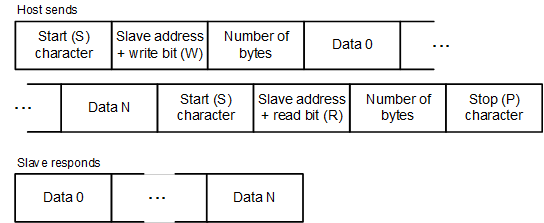SLAA908A September 2019 – September 2021 MSP430FR2032 , MSP430FR2032 , MSP430FR2033 , MSP430FR2033 , MSP430FR2153 , MSP430FR2153 , MSP430FR2155 , MSP430FR2155 , MSP430FR2310 , MSP430FR2310 , MSP430FR2311 , MSP430FR2311 , MSP430FR2353 , MSP430FR2353 , MSP430FR2355 , MSP430FR2355 , MSP430FR2422 , MSP430FR2422 , MSP430FR2433 , MSP430FR2433 , MSP430FR2475 , MSP430FR2475 , MSP430FR2476 , MSP430FR2476 , MSP430FR4131 , MSP430FR4131 , MSP430FR4132 , MSP430FR4132
3.3 Repeated Start (Read After Write)
The bridge also supports ‘read after write’ command as specified in the I2C bus specification. This allows a read command to be sent after a write command without having to issue a STOP condition between the two commands.
The host issues a write command as normal, then immediately issues a read command without sending a STOP (P) character after the write command.
 Figure 3-3 Repeated Start : Read After Write
Figure 3-3 Repeated Start : Read After Write